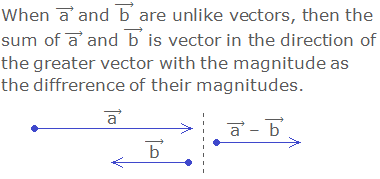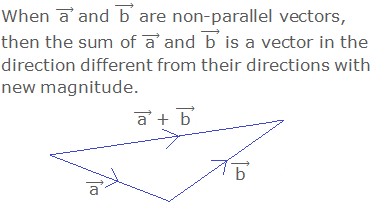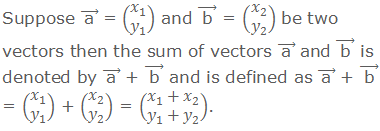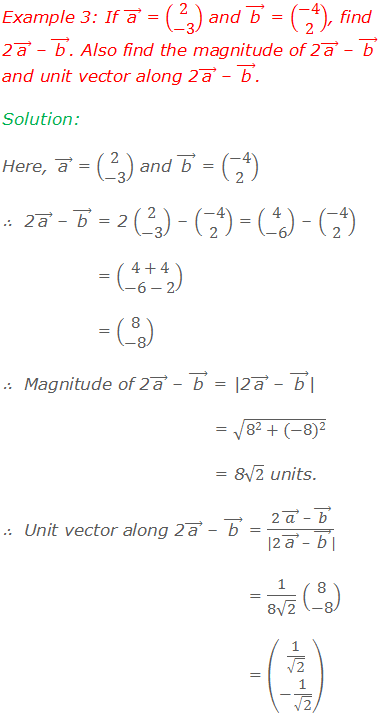
Vector Operations: The vectors can be added, subtracted or multiplied with one another. Addition of vectors, difference of vectors, multiplication of a vector by a scalar, product of vectors, etc. are called vector operations.
********************
10 Math Problems officially announces the release of Quick Math Solver and 10 Math Problems, Apps on Google Play Store for students around the world.
********************
********************
Addition of Vectors

Study the following three cases:
Case I:

Case II:

Case III:

Triangle Law of Vector Addition

Definition:
The triangle law of vector addition states that:
“If the magnitude and direction of two vectors are represented by two sides of
a triangle taken in order, then the magnitude and direction of their sum is
given by the third side taken in reverse order.”
Parallelogram Law of Vector Addition
![Parallelogram Law of Vector Addition Let ("AB" ) ⃗ = ( "a" ) ⃗ and ("AC" ) ⃗ = ( "b" ) ⃗ be two co-initial vectors completing parallelogram ABCD by taking AB and AC as adjacent sides and join diagonal AD of parallelogram ABCD. By the property of parallelogram, ("CD" ) ⃗ = ("AB" ) ⃗ = ( "a" ) ⃗ and ("BD" ) ⃗ = ("AC" ) ⃗ = ( "b" ) ⃗. Now from ΔABD, ("AD" ) ⃗ = ("AB" ) ⃗ + ("BD" ) ⃗ [By Triangle law of vector addition] i.e. ("AD" ) ⃗ = ( "a" ) ⃗ + ( "b" ) ⃗ This is called Parallelogram Law of Vector Addition.](https://blogger.googleusercontent.com/img/b/R29vZ2xl/AVvXsEjTWh4daNZqO0ng1wUP6nJpuR52mzpXmVq-WX7mPWYkYhg7Nq3uwN4epo-HjbAmJ8sU7UseHRbg0JWme-I__b4K0xQJGAh4gzgovMBkDpjmS0XS16a0lxWyXKqYOv10y02wQLuxjB1vl4kS/s16000/parallelogram+law+of+vector+addition.png)
Definition:
The parallelogram law of vector addition states
that: “If two adjacent sides of a parallelogram through a point represents two
vectors in magnitude and direction, then their sum is given by the diagonal of
the parallelogram through the same point in magnitude and direction.”
Polygon Law of Vector Addition

Definition:
The polygon law of vector addition states that:
“If a number of vectors can be represented in magnitude and direction by the
sides of polygon taken in order, their sum is given in magnitude and direction
by the closing side of the polygon taken in reverse order.”
Addition of Two Vectors in Components Form

Geometrical Proof:

Subtraction of Vectors

Multiplication of a Vector by a Scalar

Unit Vectors i And j

Worked Out Examples






![Example 7: Example 7: PQRSTU is a regular hexagon, show ("PR" ) ⃗ + ("PS" ) ⃗ + ("UP" ) ⃗ + ("TP" ) ⃗ = 3("PQ" ) ⃗. Solution: Here, PQRSTU is a regular hexagon. Join UR. Then by the property of regular hexagon, 2("PQ" ) ⃗ = ("UR" ) ⃗. Now, from ΔPRU, ("UP" ) ⃗ + ("PR" ) ⃗ = ("UR" ) ⃗ Again, from ΔPST, ("TP" ) ⃗ + ("PS" ) ⃗ = ("TS" ) ⃗ ∴ ("PR" ) ⃗ + ("PS" ) ⃗ + ("UP" ) ⃗ + ("TP" ) ⃗ = (("UP" ) ⃗ + ("PR" ) ⃗) + (("TP" ) ⃗ + ("PS" ) ⃗) = ("UR" ) ⃗ + ("TS" ) ⃗ = 2("PQ" ) ⃗ + ("PQ" ) ⃗ [∵ ("TS" ) ⃗ = ("PQ" ) ⃗] = 3("PQ" ) ⃗ Hence, ("PR" ) ⃗ + ("PS" ) ⃗ + ("UP" ) ⃗ + ("TP" ) ⃗ = 3("PQ" ) ⃗. Proved.](https://blogger.googleusercontent.com/img/b/R29vZ2xl/AVvXsEi44l7P3jgT4kDVDMTaT-yy-ujlcIe4L06YU0zL3saa7pGWzAjkZhyp_foeKT7ldvI5m3Zt59V1bvs6WsWmca-solifyUiYnggMkE5A8SHpW7wtXSQ4g3vXdTgNGxbS_wD096XVkTiTfL4W/s16000/example+7.png)
Do you have any questions regarding the vector operations?
You can ask your questions or problems here, in the comment section below.




0 comments: